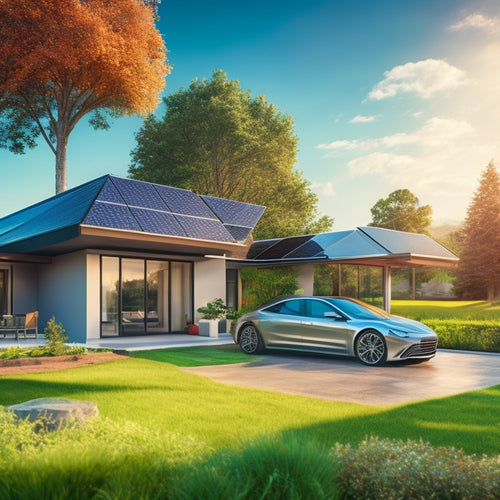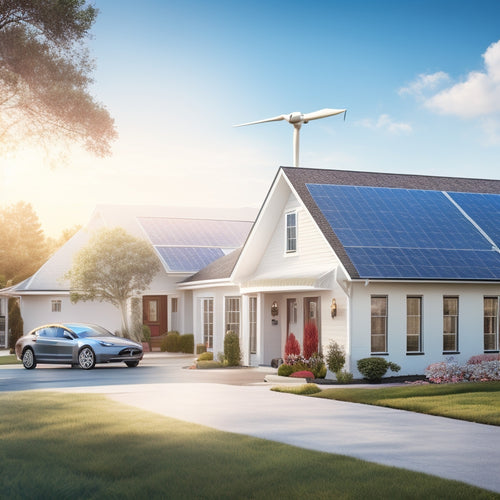
The 7-Step Solar PV Installation Checklist
Share
As you prepare for your solar PV installation project, start by evaluating the site's feasibility, examining solar energy potential, environmental impact, and cost analysis. Next, design your system, determining the right size and selecting high-efficiency panels. Then, obtain necessary permits, guaranteeing compliance with local regulations. Prepare your roof and site by inspecting conditions, checking accessibility, and assessing obstructions. After that, install your solar PV equipment, focusing on secure mounting, proper connections, and inverter installation. Inspect and test your system to verify it meets expected energy production levels and safety standards. Now, get ready to tackle the finer details that'll make your installation a success.
Key Takeaways
- Conduct a thorough site feasibility assessment to identify potential installation challenges and opportunities.
- Ensure a well-designed system that meets energy requirements and local regulations through proper permitting and system design.
- Install solar PV equipment according to manufacturer instructions and local regulations to ensure safe and optimal performance.
- Perform a comprehensive system inspection and testing to identify and address any issues or adjustments needed.
- Implement electrical testing and safety procedures to ensure the system is secure, efficient, and compliant with industry standards.
Assess Site Feasibility
How much electricity can your property realistically generate from solar power? To assess site feasibility, you need to evaluate your property's solar energy potential. Consider the amount of sunlight your location receives, taking into consideration shading, orientation, and latitude. A thorough analysis will help you determine the maximum amount of electricity you can generate.
Next, consider the environmental impact of your solar installation. While solar energy is a clean source of power, you should still assess the potential effects on local wildlife and their habitats.
A thorough cost analysis is also essential, factoring in the initial investment, funding options, and long-term savings. Stay up-to-date with technology advancements, as they can greatly influence the efficiency and cost of your installation.
Additionally, think about maintenance practices and how they'll affect your system's performance over time.
Design Solar PV System
With a solid understanding of your property's solar energy potential, you can now focus on designing a solar PV system that meets your energy needs. This involves selecting the right solar panel types and configuring them to optimize energy efficiency.
Determine the ideal system size based on your energy requirements and available roof space. Consider the wattage, voltage, and current output of each panel to guarantee they match your energy needs. Choose panels with high energy efficiency ratings to maximize power output per unit area.
Consider the system's mounting and tracking requirements. Will you use a fixed-tilt mount or a tracking system to maximize energy output? Verify the system's electrical components, such as inverters and combiner boxes, are compatible with your chosen panel configuration.
Create a detailed system design and simulation to visualize your solar PV system's performance. This will help you identify potential bottlenecks and optimize the system for maximum energy production.
Obtain Necessary Permits
Before commencing the installation process, you must secure the necessary permits and approvals to confirm compliance with local regulations and building codes.
Failure to obtain these permits can result in fines, penalties, or even project cancellation.
Identify the required permit types for your solar PV installation, which may include electrical, building, and zoning permits.
Verify you understand the specific requirements for each permit, as these vary depending on your location and local authorities.
When preparing your permit application, gather all necessary documents, including your system design plans, specifications, and equipment lists.
Accurately complete the application forms, and double-check for errors or omissions.
Submit your permit application to the relevant authorities, along with the required fees.
Wait for approval before proceeding with the installation.
Be prepared to address any concerns or issues raised by the authorities, and make necessary revisions to your application.
Prepare Roof and Site
You'll need to assess your roof's condition to confirm it can support the weight of the solar panels and withstand environmental factors.
Next, you'll want to check the site's accessibility to verify that the installation team can easily move around and transport equipment.
Roof Condition Assessment
Reliability is key when it comes to a solar PV installation, and it starts with a thorough roof condition assessment.
You'll need to evaluate your roof's material type, age, and condition to guarantee it can support the weight and durability requirements of your solar panels. Common roof material types include asphalt shingles, metal, clay tile, and slate, each with its own set of considerations.
Next, you'll need to assess the roof's orientation and angle. Solar panels perform best when installed at an angle between 30-40 degrees, facing south. However, you may need to adjust the orientation depending on your location and the surrounding environment.
Additionally, inspect your roof for signs of wear and tear, such as cracked or missing tiles, curled or buckled shingles, and damaged flashing.
You should also check for any obstructions, like skylights, vents, or chimneys, that could hinder the installation or performance of your solar panels.
A thorough roof condition assessment will help you identify any potential issues and guarantee a safe and efficient solar PV installation.
Site Accessibility Check
Now that you've evaluated your roof's condition, it's time to prepare the site for installation. This step is vital to guarantee a smooth and efficient installation process. You need to assess the site's accessibility to determine the best approach for the installation team and equipment.
Consider the following factors to optimize your site layout:
-
Clearance: Verify that the installation team has enough space to maneuver around the roof and surrounding areas.
-
Obstacles: Identify any potential obstacles, such as trees, power lines, or neighboring buildings, that could hinder the installation process.
-
Tool accessibility: Confirm that installation tools, such as ladders and equipment, can be easily transported to the roof.
- Parking and storage: Designate areas for parking and storing equipment, materials, and tools to keep the site organized and safe.
Structural Integrity Verification
The roof's structural integrity is a critical factor in guaranteeing a safe and successful solar PV installation. You must verify that your roof can support the weight of the solar panels and withstand various environmental conditions. This involves evaluating the load-bearing capacity of your roof, which depends on the type of roof materials used.
| Roof Material | Load-Bearing Capacity | Additional Considerations |
|---|---|---|
| Asphalt Shingles | 2-3 pounds per square foot | Check for damaged or missing shingles |
| Clay or Concrete Tiles | 4-5 pounds per square foot | Confirm tiles are securely fastened |
| Metal Roofing | 3-4 pounds per square foot | Consider the type of metal and its thickness |
| Slate Tiles | 5-6 pounds per square foot | Check for cracks and loose tiles |
You should also inspect the roof's underlying structure, including the rafters, trusses, and joists, to guarantee they're in good condition. Additionally, check for any signs of water damage, rot, or pest infestation that could compromise the roof's integrity. By verifying your roof's structural integrity, you can confirm a safe and successful solar PV installation that meets local building codes and regulations.
Install Solar PV Equipment
You'll need to carefully plan and execute the installation of solar PV equipment to guarantee a safe and efficient system. This involves selecting the right solar panel types and installation techniques for your specific setup.
-
Mounting the solar panels: Confirm the panels are securely fastened to the roof or mounting system to withstand environmental stresses.
-
Connecting the panels to the inverter: Properly connect the panels to the inverter, taking care to match the voltage and current ratings.
-
Installing the inverter and monitoring system: Mount the inverter and monitoring system in a well-ventilated area, away from direct sunlight and moisture.
- Running the electrical wiring: Run the electrical wiring from the inverter to the main electrical panel, following local electrical codes and regulations.
Remember to follow the manufacturer's instructions and local regulations to confirm a safe and efficient installation.
Inspect and Test System
You'll now conduct a thorough inspection and testing of the solar PV system to guarantee it's safe and functioning as expected.
This involves performing a system safety check to identify any potential hazards, analyzing the PV performance to verify it meets the design specifications, and following electrical testing procedures to validate the system's electrical integrity.
System Safety Check
How thoroughly have you inspected and tested the solar PV system to verify it meets safety standards?
You must guarantee that your system is designed and installed with safety in mind to prevent electrical shock, fire hazards, and other potential risks.
To conduct a thorough system safety check, inspect and test the following:
-
Electrical connections: Verify that all electrical connections are secure, meet industry standards, and are protected from environmental factors.
-
Grounding systems: Confirm that the grounding system is properly installed, bonded, and meets local electrical codes.
-
Safety protocols: Develop and implement safety protocols for emergency procedures, such as shutdowns, lockouts, and first aid.
- Labeling and signage: Confirm that all electrical components, including disconnects, inverters, and electrical panels, are properly labeled and signed to prevent accidental energization.
PV Performance Analysis
What metrics will you use to evaluate the solar PV system's performance and identify potential issues? You'll need to inspect and test the system to guarantee it's operating at ideal levels.
Start by analyzing the performance metrics, including energy output, voltage, current, and power quality. These metrics will help you identify any deviations from the expected performance and pinpoint potential issues.
Next, focus on efficiency monitoring to determine how well the system is converting sunlight into electricity. Check the inverter's efficiency, as it plays a vital role in maximizing energy production. Verify that the inverter is operating within the manufacturer's specified efficiency range.
Inspect the system's components, such as the panels, inverters, and mounting structures, for signs of damage, wear, or corrosion. Look for any issues that could impact performance, such as shading, debris, or misalignment.
Electrical Testing Procedures
During the electrical testing procedures, approximately 80% of solar PV system faults can be attributed to electrical connections and wiring issues. This highlights the importance of thorough testing to guarantee a safe and efficient system.
You'll need to perform a series of tests to verify the system's electrical integrity.
-
Voltage testing: Verify that the system voltage matches the manufacturer's specifications to prevent damage to components.
-
System grounding: Confirm the system is properly grounded to prevent electrical shock and fires.
-
Insulation resistance testing: Check for any insulation breaches that could lead to electrical faults.
- Continuity testing: Verify that all electrical connections are secure and continuous.
Frequently Asked Questions
Can I Install Solar Panels on a Metal Roof?
You can install solar panels on a metal roof, but you'll need to evaluate specific metal roof considerations, such as ensuring a watertight seal and using compatible clamps; however, you'll also enjoy installation advantages like reduced weight and increased durability.
How Long Does a Typical Solar Installation Take?
Like a skilled conductor leading an orchestra, you'll steer the installation process, which typically takes 3-5 days for a residential project, with the entire project timeline spanning around 2-3 months from permit to final inspection.
Do Solar Panels Work During Power Outages?
You'll be glad to know that solar panels alone won't work during power outages, but with battery storage, you can achieve grid independence, ensuring your lights stay on even when the grid goes dark.
Can I Add More Panels to My Existing System?
You can add more panels to your existing system, but you'll need to guarantee panel compatibility and obtain new installation permits; consult with a pro to assess your system's capacity and local regulations to make it happen.
Are Solar Panels Affected by Shade From Trees?
You'll notice that tree shade considerably reduces panel efficiency, as even partial shading can decrease energy production by up to 20%. You'll want to assess tree growth, pruning, or relocation to minimize shade and optimize your solar panel performance.
Related Posts
-

What Solar Panels Work Best With EVS Online?
When shopping for solar panels online to power your electric vehicle, look for high-efficiency models that can withst...
-

Why Homeowners Are Embracing DIY Energy Independence
By taking control of your energy needs, you're breaking free from the uncertainty of utility bills and embracing a se...
-

What Makes a Road Bike-Friendly by Design?
As you plan and design roads, incorporating features like dedicated bike lanes, smooth surfaces, and traffic calming ...


